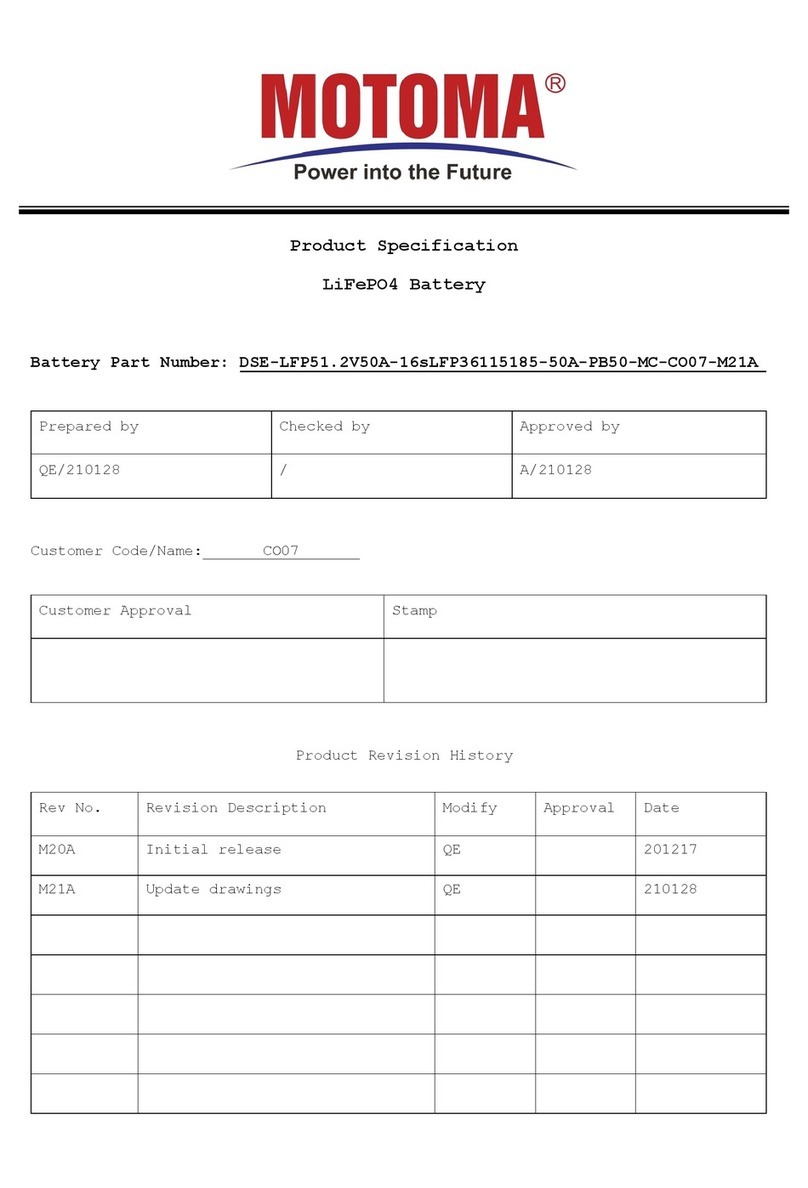
MOTOMA POWER CO., LTD
Http: // www.motoma.com
E-mail: info@motoma.com
Manufacturer reserves the right to alter or amend the design, model and specification without prior notice.
6 / 7
shocks, leakage of battery fluid and heat generation.
Do not remove the outer tube from a battery or damage it. Doing so will expose the battery to
the risk of a short circuit, and may cause leakage of battery fluid, heat generation, explosion
and fire.
If MOTOMA batteries leak fluid, change color, change shape, orchange in any other way, do
not use them, otherwise they may cause heat generation, explosion and fire.
Keep MOTOMA batteries and the equipment using them out of the reach ofbabies and small
children, in order to avoid accidental swallowing of the batteries. In the event the batteries are
swallowed, consult a doctor immediately.
If the operating time of a MOTOMA battery becomes much shorter than its initial operating
time even after recharged, it should be replaced to a new battery as its battery life has ended.
9. CAUTION!
Never dispose of MOTOMA batteries in a fire or heat them.
Store MOTOMA batteries out of the reach of babiesand small children. When charging or
Using battery, do not let babiesor small children remove the battery from the charger or the
equipment during used.
Be sure to use the recommended charging method for MOTOMA batteries read the battery
charger’s instruction manual carefully.
Do not use old and newbatteries mixed together, orbatteries at different charge levels. Do not
use the MOTOMA battery mixed with a dry cell or other batteries of different capacity, type, or
brand name. This may cause leakage of battery fluid and heat generation.
If the MOTOMA batteryterminals become dirty, clean up them with a soft drycloth prior to use.
Dirt onthe terminals can result in poor contact with the equipment, loss of power, or inability to
charge.
After long term storage, there is a possibility that the battery could not be fully charged. In
order to fully charge it, please charge and discharge battery for a few times.
Only charge MOTOMA batteries using those specific chargers that satisfy MOTOMA’s
specifications. Only charge batteries under the conditions specified by MOTOMA.
Never solder lead wires directly on to MOTOMA batteries
Do not directly connect MOTOMA batteries to a directpower source or the cigarette lighter
socket in a car.
When MOTOMA batteries are to be incorporated in equipment or housed within a case, avoid
air-tight structures, as this may lead to the equipment or the case being damaged or may be
harmful to users.
Any other problems caused by malfunction of the equipment or misuse of the battery are not
under this warranty.

























